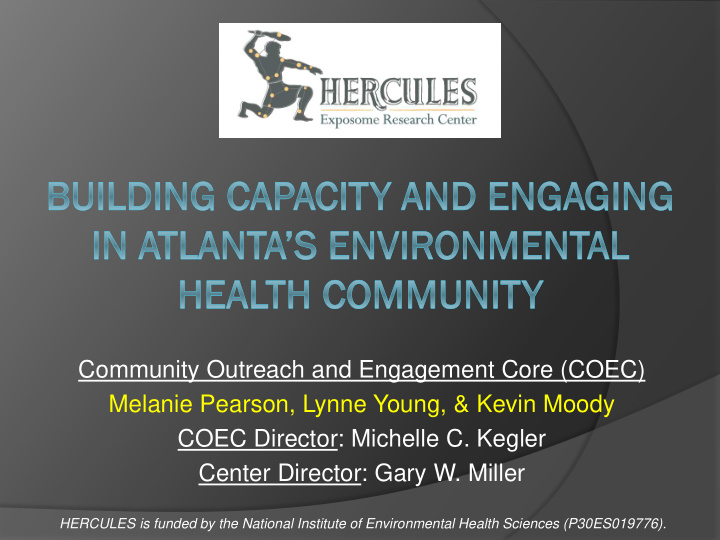



Community Outreach and Engagement Core (COEC) Melanie Pearson, Lynne Young, & Kevin Moody COEC Director: Michelle C. Kegler Center Director: Gary W. Miller HERCULES is funded by the National Institute of Environmental Health Sciences (P30ES019776).
HERCULES scientific theme: Exposome
An “exposome” analogy… Human body ≈ bucket Each person has a bucket. Everyone’s bucket is a different size. When the bucket is full, the person becomes sick.
Bucket is half-full for many living in a resource-limited community. Exposures/Challenges: • Poverty • Limited access to nutritious foods • Limited access to healthcare • Lack of exercise • Safety threats / stress • Air pollution/traffic emissions • Exposure to pesticides • Exposure to mold or lead • Impaired waterways
The Exposome is a scientific approach to measuring the “whole” bucket.
The Exposome can help identify communities that face multiple pollutants and/or are more vulnerable to these pollutants.
Important bucket tidbits… The size of a person’s bucket can change over time. Parental exposures can change the size of future children & grandchildren’s buckets. Healthy interventions can “remove” stressors from a bucket.
Why community engagement is important to exposome science New approach – perfect time to have community input – keeps scientists on track and keeps it relevant to real world experiences! Vital community knowledge about exposures can be integrated into science. To be translated into action, community guidance is required.
Community Engagement Goals (Shaped by the community from the beginning) Short-term Long-term Develop partnerships Partnerships with local community (including research and stakeholders collaborations) HERCULES scientists between a community learn local concerns group and Share scientific HERCULES scientist knowledge with Incorporate community community concerns Build capacity: into science. ○ Community ○ Scientists ○ Healthcare providers Unexpected: city level interest/impact
Keys to success… Engaged stakeholders Shared mission “Safe/neutral space” Stakeholders are decision-makers ~executive board Decide activities, process, budget priorities
Lynne Young
Atlanta’s Environmental Health Community Multiple exposure concerns in Atlanta is coalescing around Atlanta communities. environmental health disparities. Exposome is an all-encompassing Many community-based theme that provides an umbrella organizations that focus on a for all environmental health specific environmental health concerns in the community. concern and/or a specific neighborhood/community. Wealth of expertise in communities, at universities, and government agencies (from county health departments to the EPA). Existing partnerships b/n many. New partnerships bring strength in environmental health science.
Stakeholder Advisory Board 30+ members — community members, non- profit organizations, government agencies, academic partners
The Clarence “Shaheed” DuBois Community Grant Program* $2500 for one-year project Year One Projects: 1. photovoice of street-level environmental health hazards 2. urban farm providing healthy food to Atlanta’s homeless 3. training for immigrant- and refugee-farmers on local growing 4. awareness campaign to educate an immigrant/refugee community about second-hand smoke health risks Year Two Projects: 5. food garden improvements and training for senior citizens 6. expansion of and training in an urban garden 7. education and awareness in a low-resource, flood-prone community 8. hazardous waste disposal education information for refugee apartment residents *Community partners helped develop the RFA and review/score the applications
HERCULES Community Technical Assistance Program* Practical support and hands-on mentoring to address local environmental health concerns *Community partners helped develop the application process and the application.
Proctor Creek Community Collaborative Health Survey High prevalence of observed mold High asthma prevalence Mold likely due to maintenance issues in addition to flooding
Community Forum: Environment, Health, & Action o Small-group discussions: experts at each table o Community collaborative problem solving models o SC State Rep, Mr. Harold Mitchell, Jr., shared story of overcoming environmental injustice . Advisory Board members determined these meeting elements
Community Resource Guide
HERCULES Holiday Party Informal interactions between scientists, students, & community – helps build trust
Keys to success Emphasis on strengthening community capacity Implementing suggestions from community members Facilitating participation by community members Promoting relationships and partnerships between Board, scientists and community.
Kevin Moody
HERCULES SAB Adds Value to Public Sector Value-Added: Scalable and Transferable! Criteria: Health Equity / Eliminate Disparities ○ Who lives past age 85 and enjoys a great quality of life
HERCULES SAB Adds Value to Public Sector SAB as Public Involvement Model for Better Decisions 1. Inclusive Community-Based Change ○ Civic Actions and Leadership Skills (Vision to Action) Scientist – Community Feedback Loop 2. Fosters Robust Underlying Assumptions ○ Which are Logically Coherent & Transparent, and ○ Improve Transparency: Decision-Making under Uncertainty Bayesian Strategy; Learning Organization; Adaptive Management
emoryhercules.com
Recommend
More recommend